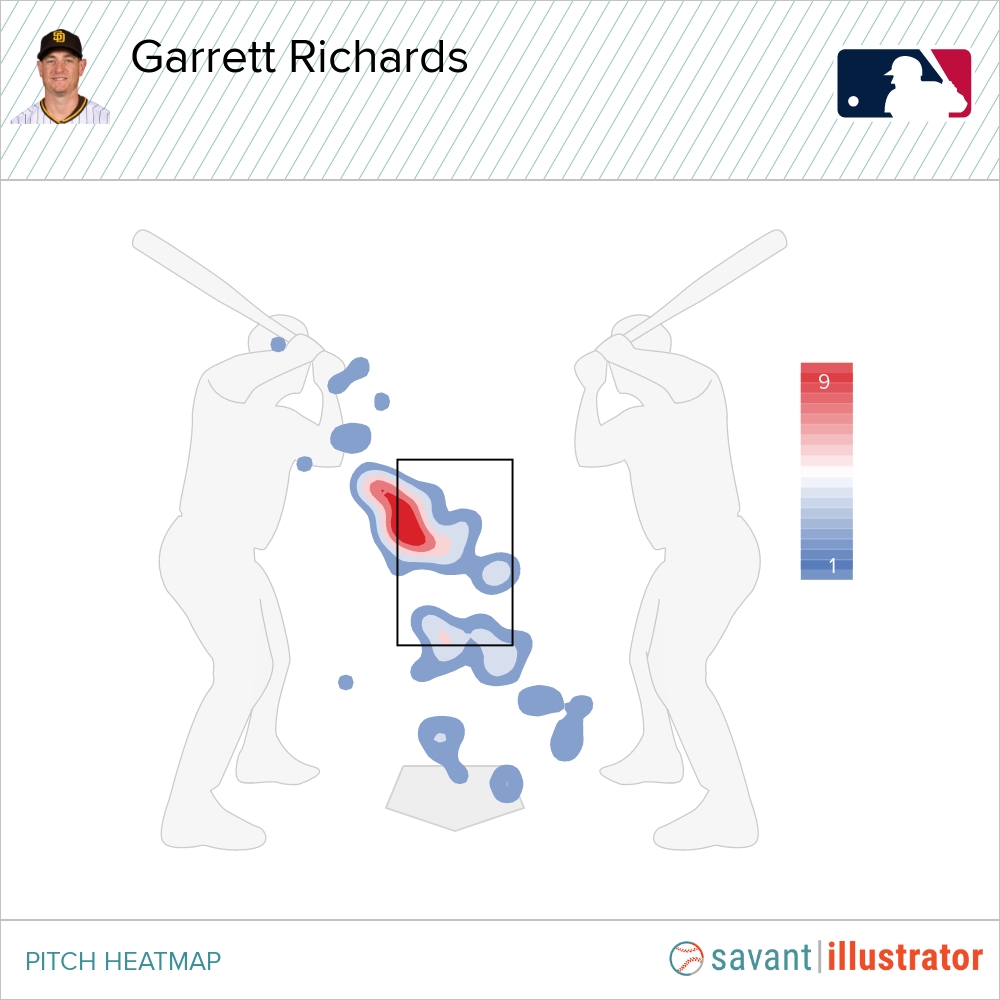From 2013-2015, Garrett Richards posted a 3.45 ERA across 512 innings of work, including a 32 start/207 inning campaign in 2015. He had become the de-facto Angels ace by 2014 and was mere votes shy of an All-Star Game nod following a dominant first half.
In the five years since he has thrown a combined 198 innings and failed to top 16 starts in a season.
To say Richards suffered unfortunate injury luck would be an understatement. A freak knee injury while covering 1B in 2014 ended his breakout season prematurely, but he came back in 2015 and posted 2.8 fWAR over a healthy 207 innings.
Though he recovered well from his knee injury, the arm injuries began soon after. A torn UCL ended his 2016 season after just 6 starts, but he opted against TJS—something the Angels have a weird affinity for. Season-ending flare-ups ended both his 2017 and 2018 seasons, leading to the eventual TJS heading into free agency. The unfortunate timing led him to sign a backloaded two-year deal with the Padres (in line with typical contracts for injured free agents).
With a brief three-start stint at the tail end of 2019, Richards entered 2020 healthy for the first time in a while, vying for a rotation spot on a young Padres roster. Though the 2020 season was shortened, Richards won a rotation spot and managed to stay healthy for its entirety. Though he may not be the ace he looked destined to be in 2014, it was a step in the right direction for the just-turned 32-year-old as he joins the Red Sox on a 0ne-year deal.
*Intrigue*
Richards has always been surrounded with intrigue, but the dominant stretch in 2014 may have unfairly influenced your perceptions (it certainly influenced mine).
Injuries aside, his overall body of work is good, but not nearly as good as you might’ve thought:
That’s basically league average (108 ERA+) over a full season, though the caveat is that Richards has yet to be healthy for an entire 162 game slate. No doubt a serviceable big league starter, but fairly unremarkable for someone who has flashed ace potential.
The Good Stuff
The driving force behind Richards’ hype throughout his career has been his stuff, with a fastball/curveball combination that is perennially atop the spin rate leaderboards.
| Season | FF | CB |
|---|---|---|
| 2015 | 98 | 99 |
| 2016 | 97 | 99 |
| 2017 | 99 | 100 |
| 2018 | 99 | 100 |
| 2020 | 97 | 99 |
(Spin rate percentiles from 2015-2020 via Baseball Savant)
Richards can spin it with the best of ’em, but spin rate isn’t everything. In fact, despite the high spin rate, Richards has never really relied on his curve.

The SL is—and always has been—his go-to secondary.
With just two inches of horizontal movement, his slider profiles more like a slurve anyway. Though not his most used pitch overall, he went to it well over 50% of the time when ahead in the count. It was his best pitch in 2020, with a .264 xwOBA against, 39% whiff-rate, and 26% putaway rate.
He sets up the slider with a four-seamer, which as mentioned has a 99th percentile spin rate. We typically associate that much spin on a four-seamer with good ride—and in turn, whiffs. But here is where things get interesting; Richards’s four-seamer has “natural cut,” and averages 19 inches of drop, which is four inches below league average and well below average for a pitch with that much spin. That’s on par with most cutters. But unlike most cutters, it has zero inches of horizontal movement, which even for typical four-seamers, is rare.
That’s not to say we haven’t seen this profile before. The downside to naturally cutting fastballs is that they tend to run into barrels. It’s a fixable trait. One that resembles the pre-Rays versions of Tyler Glasnow and Peter Fairbanks, whom Tampa helped turn into whiff-generating weapons, and the present version of Luis Patiño, whom Tampa will likely help make similar alterations.
But Richards’ four-seamer doesn’t give up a ton of barrels either.
At this point, you are likely just as confused as I was. How can a four-seamer like this induce so few whiffs while also not getting obliterated on a regular basis?
Such little ride and fade on a pitch with that much spin can only be explained by one thing: Gyro spin.
Gyro spin is a rare sidespin that has very little impact on the ball’s movement, evidenced by Richards’ league-low spin efficiency. Gyro spin is usually found in sliders, with the few existing gyro fastballs attributed to side-armers or pitchers with below-average spin rates—something Richards excels at.
The effect of this unique profile is that batters struggle to pick up the pitch out of his hand. It doesn’t have the cut or fade that a sinker or cutter would, but it doesn’t have the rise that a four-seamer would either. With the lack of horizontal movement it doesn’t run into barrels, instead simply dropping below them. The result is lots of weak/topped batted balls, and overall some weird off-balance swings.
The right spin efficiency is paramount for cut-fastballs though, which are most effective in the 45-65% range. With higher active spin they will flatten out (losing the effective drop), and with lower active spin will essentially morph into a hanging slider. At 49.7%, Richards is comfortably in that range.
So Richards’ high-spin four-seamer is pretty good, but not for the reasons high-spin four-seamers typically are.
There are just a few other pitchers who throw a four-seamer like this, the most notable being Spencer Turnbull, whose own unique spin metrics have sparked numerous research pieces since he debuted in 2018. If you are one of the many that hype Turnbull as a fantasy sleeper, you should be hyping up Richards for all the same reasons.
Along with an occasional sinker to left-handed hitters, the curveball rounds out Richards repertoire. Once again the spin rate jumps off the page, but with just 7.5% usage and middling results, it is nothing more than a change-of-pace offering. He often tries to get looking strikes with it (to varying degrees of success), which helps explain its questionable heat map.

Where Does This Leave Him?
Richards is a 32-year-old starter with a lengthy injury history and one of the most unique movement profiles in the league. Is he worth the one-year, $10 million deal the Red Sox gave him? Probably. That seems about right for a mid-rotation starter, and there is no such thing as a bad one-year deal. With a rebuild in mind, the Red Sox will likely do whatever they can to maximize his value by the trade deadline. He fits in amongst a fragile-looking rotation, and shouldn’t be relied upon to eat innings. They could even move him to the bullpen, where his spotty command and two-pitch mix would fit in just as well.
The stuff is still very intriguing, albeit in a different way than was previously thought. It’s possible the Red Sox change nothing, and Richards continues to gyro spin his way to league average results. But it’s also easy to see a connection with Chaim Bloom and the Rays history of altering similar pitches. Might the Red Sox attempt to refurbish Richards’ repertoire to generate more whiffs? It’s within the realm of possibility, and one I will certainly be watching for in 2021.
Photo by Samuel Stringer/Icon Sportswire | Design by Quincey Dong (@threerundong on Twitter)

